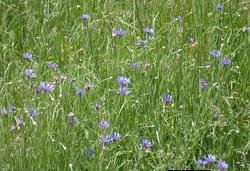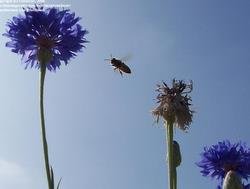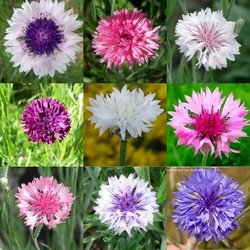





Ahhh, the cornflowers. I can never have enough of them. No matter how down and out we find ourselves, one look at these soothingly blue flowers will make us smile right out loud. Here is another story straight from my childhood, all about blue cornflowers. By the way, have you started your seeds yet?
"When you take a flower in your hand and really look at it, it is your world for the moment." Georgia O'Keefe
I was very young when I met an older woman who was visiting the church where my grandfather was minister. I was eyeing the yardage in the blindingly yellow billows of her taffeta skirt that bounced from one pew to the other as she swayed her way down the aisle toward me. My grandmother introduced me to her and as I raised my eyes from her yellow skirt to her face above me, she said very loudly: "Well, wouldja look at them cornflower blue eyes."
I looked up at my grandmother and said loud and clear: "But Ninna, corn's yellow an' I don't got yellow eyes, I don't even like yellow, now do I?" My grandmother, whose eyes matched mine, said, " Doesn't look like it to me." And the woman with her yellow taffeta skirt and a loud "harrumph" bounced away. That was one moment my family never let me forget. And I never forgot the twinkle in Ninna's blue eyes when she spoke.
The cornflower, Centaurea cyanus, is for most of us a garden favorite. It is an easily cultivated annual that has many varieties and colors, but the predominant color is blue. It is often called bachelor's button and the older ladies in my family told me that bachelors put the flower in their top buttonhole when they went courtin' if they were courtin' a girl with blue eyes. They knew as much then as Wikipedia knows now, I sometimes think, but Wiki adds this to the origin of that name: 'Firstly, its appearance suggests a cloth button as worn in the Middle Ages, and secondly, it was carried by bachelors as some sort of good luck charm in their dealings with their true loves.' I don't remember that my boyfriend, Billy, ever stuck a cornflower in his buttonhole when he came courtin'.
Originally native to the Mediterranean, the plant was so completely naturalized in England, where it was common in grain fields, that farmers looked upon it as a weed. They, too, had a common name for it calling it "hurtsickle" because of its tough stem, which blunted their sickles. It has been so widely cultivated in North America, the cornflower has escaped from gardens and become naturalized. I am not sure why, but according to folklore, the plant was used centuries ago to treat inflammations of the eyes. It could be that ancient herbalists thought that if it matched some eye color, then it should be beneficial to the eyes. That was the way of the ancients, if it looked like a body part, or was the color of a body part, then it should be beneficial to the body part. I'd rather look at them, than have their drops put in my eyes, but a decoction of the dried flowers has been used to treat eye inflammations.
It is an annual herb, with an erect, wiry, downy stem that grows 1-2 feet high, and is branching. At the ends of the branches grow solitary, thistle like, brilliant blue flowerheads. Long grayish-green leaves are alternate, lance shaped and downy like the stem. Research concerning cornflower's medicinal value indicates that it may have some effect as an astringent, or a substance that causes contraction of tissues and thus stops bleeding. This effect is of course a result of the tannin content of the plant. Today's pharmacologists find little evidence to support its treatment of fevers, even though it was thought to be beneficial at one time when our ancestors steeped the leaves or seeds in wine and used it as a treatment for pestilential fevers.
The Latin name of the plant refers to a mythical centaur that the ancient Greeks worshipped as the father of medicine. No matter its name, or its medicinal possibilities, my mother had cornflowers growing all over our gardens in the front, the back, and both sides. Some even took up residence in the back of our vegetable garden. And sometimes if I was really lucky, there would be a few pink or white blooms amidst the blue. It was always amazing to me that a huge cluster of them could look so much like a blue lake, when I saw them from a distance.
I did not know them as cornflowers when I met the yellow clad, gargantuan woman at church that day. I called them bachelor's buttons. If I had known them as cornflowers at that time, I might have smiled and said, "Thank you." Blue eyes fade with age, I think, but if anyone ever again tells me I have cornflower blue eyes, you better believe I will be delighted.
http://en.wikipedia.org/wiki/Centaurea_cyanus
From Plant Files, thanks to: Dave, pupilpropogtr, redchic01, crimsontsavo, starshine, croclover, Jeff_Beck and Tashmoore.
(Editor's Note: This article was originally published on March 3, 2009. Your comments are welcome, but please be aware that authors of previously published articles may not be able to promptly respond to new questions or comments.)
Copyright © www.100flowers.win Botanic Garden All Rights Reserved